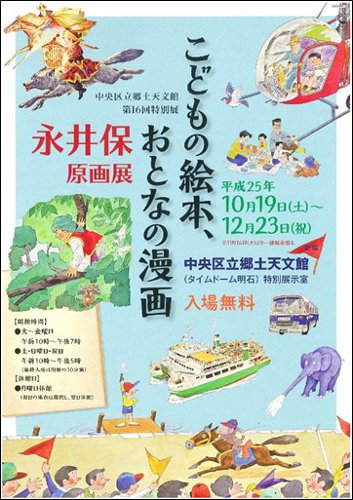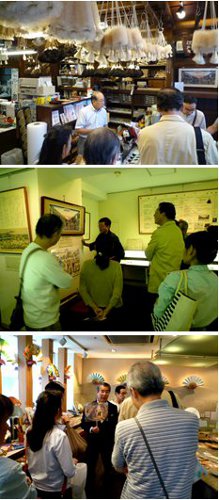The 16th special exhibition "Children's Picture Book, Adult Manga-Tamotsu Nagai Original Painting Exhibition-" has started at Chuo Ward Folk Tenmonkan (Time Dome Akashi). Born in Nihonbashi, Tamotsu Nagai was active in manga, illustrations, watercolor paintings, essays, etc. from the early Showa era to the Heisei era. A selection of works are exhibited from the donation of more than 4,000 relics. The exhibition will be closed on Monday until December 23. Admission free, catalogs (A4 size color printing, 48 pages) are distributed for a fee (200 yen).
 Tamotsu Nagai was born in 1915 (1915) in a house in the handling (mergering) business in Honmachi (currently around Nihonbashi Honmachi) and went to Jushi Elementary School. I studied with interest in painting since I was a child, and when I was 23 years old, door paintings were adopted in magazines. At the age of 27, he served on the southern battlefield as an army advertising team. He is a doujin of the manga group, and is active in the manga world, including illustrations of "Picture Book Kinder Book". He also serialized picture essays in "Ginza Hundred Points" and "Monthly Nihonbashi". He died in 2004 at the age of 88.
Tamotsu Nagai was born in 1915 (1915) in a house in the handling (mergering) business in Honmachi (currently around Nihonbashi Honmachi) and went to Jushi Elementary School. I studied with interest in painting since I was a child, and when I was 23 years old, door paintings were adopted in magazines. At the age of 27, he served on the southern battlefield as an army advertising team. He is a doujin of the manga group, and is active in the manga world, including illustrations of "Picture Book Kinder Book". He also serialized picture essays in "Ginza Hundred Points" and "Monthly Nihonbashi". He died in 2004 at the age of 88.
In paintings and illustrations, about 10% of the landscape sketches are depicted in Chuo-ku. As a memory of Nihonbashi, the scenery of the beautiful days of the fish shore and Honodawara town is preserved. War paintings such as watercolors depicting the scene of the soldier departs are lined up in the works during the service. After returning from the battlefield, in September 1945, shortly after the end of the war, a pictured letter sent to his family on the middle day of the equinoctial week was just like emakimono.
The manga group, which was reorganized after the war, was headed by Nagai, and eventually joined by famous manga artists such as Taizo Yokoyama, Yoshiro Kato, Isao Kojima, and Osamu Tezuka. The materials of the activities and trends of the group recorded by Nagai are valuable. In addition to being active in four-frame comics and satire paintings, he has also left many works in picture books and magazines for children. Among them, "Kinder Book" (published by the Fravelkan) has been working since the 20s and displays original paintings of its colorful and fun patterns.
"Ginza Bayashi" serialized in the town magazine "Ginza Hundred Points" in 1967 (1967)-1944, and "Nihonbashi Memoricho" serialized in "Monthly Nihonbashi" from 1979 (1979) to 1962 I am interested in. "Ginza-" shows the pre-war Ginza customs. "Nihonbashi-" depicts the old New Year's scenery and townscape of Nihonbashi.
This special exhibition is beyond the boundaries of a single manga artist, and it seems that a sharp look at the times and society when Tamotsu Nagai's perspective and sensitivity were captured. This exhibition is different from the hard history story, and as an artist who experienced before and after the war, is worth seeing at first glance. @ Akira Makibuchi
◇Click here for the website of the Local Tenmonkan special exhibition.>>
 Tamotsu Nagai was born in 1915 (1915) in a house in the handling (mergering) business in Honmachi (currently around Nihonbashi Honmachi) and went to Jushi Elementary School. I studied with interest in painting since I was a child, and when I was 23 years old, door paintings were adopted in magazines. At the age of 27, he served on the southern battlefield as an army advertising team. He is a doujin of the manga group, and is active in the manga world, including illustrations of "Picture Book Kinder Book". He also serialized picture essays in "Ginza Hundred Points" and "Monthly Nihonbashi". He died in 2004 at the age of 88.
Tamotsu Nagai was born in 1915 (1915) in a house in the handling (mergering) business in Honmachi (currently around Nihonbashi Honmachi) and went to Jushi Elementary School. I studied with interest in painting since I was a child, and when I was 23 years old, door paintings were adopted in magazines. At the age of 27, he served on the southern battlefield as an army advertising team. He is a doujin of the manga group, and is active in the manga world, including illustrations of "Picture Book Kinder Book". He also serialized picture essays in "Ginza Hundred Points" and "Monthly Nihonbashi". He died in 2004 at the age of 88. From Kodemmacho Station on the Tokyo Metro Hibiya Line, cross Ebisu Street and head west along Daidenma Honmachidori on the old Nikko Kaido, you will see "Edoya-san" (pictured above). Various shapes of products are hung from the ceiling in the store and are spectacular. It is said that the number of products made of materials and shapes tailored to the application is 3,000.
From Kodemmacho Station on the Tokyo Metro Hibiya Line, cross Ebisu Street and head west along Daidenma Honmachidori on the old Nikko Kaido, you will see "Edoya-san" (pictured above). Various shapes of products are hung from the ceiling in the store and are spectacular. It is said that the number of products made of materials and shapes tailored to the application is 3,000.
